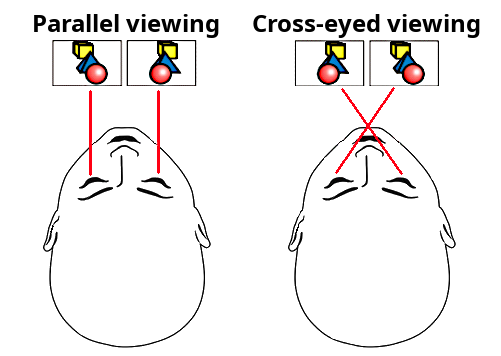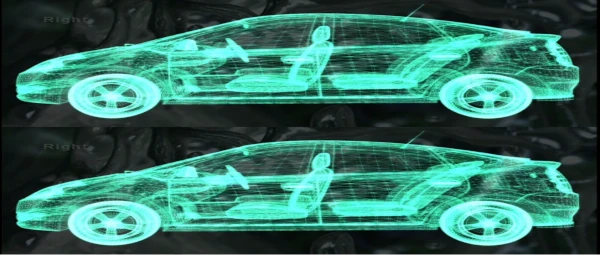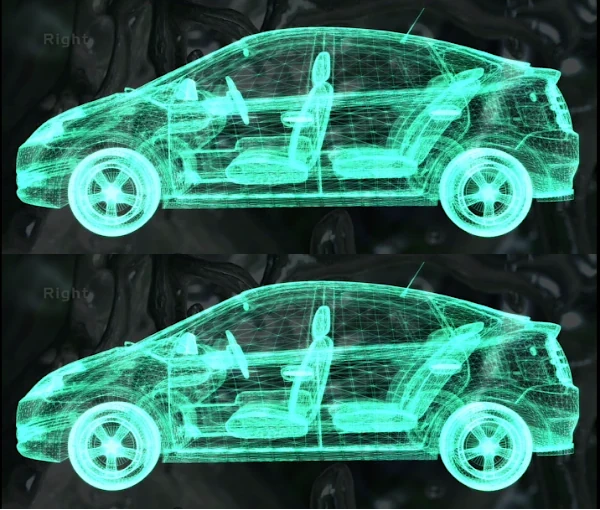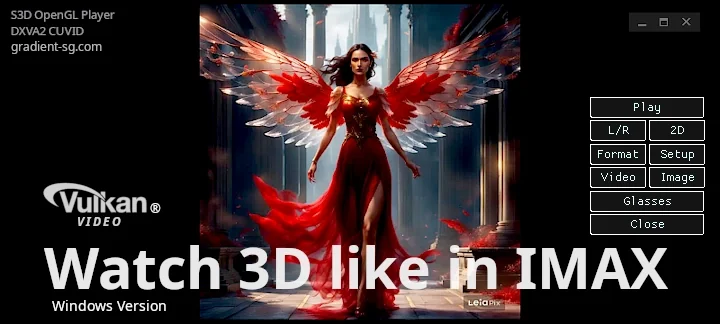The S3D Video player is designed for displaying 3D media using active shutter glasses on your computer. It allows you to configure your PC for watching 3D shows with maximum possible quality. If your PC and display are fast enough, image looks better than a 3D IMAX cinema.
The solution does not require expensive equipment and works with many computer models. You can use any glasses from the list of compatible devices. Before purchasing any equipment, test the player software. If 3D stereo video plays smoothly and steadily, without small freezes or dropped frames, it means your computer has sufficient performance.
Should add to PC:
S3D Emitter synchroniser
Any Compatible 3D Glasses:
S3D Glasses bluetooth, or
3D IR Shutter glasses, or
DLP Link glasses, just $10 only
Demo Media files:
3D Art, Movies, Photo, Pictures
Avatar 'Fire and Ash' Trailer 3D
We are release a simple version so you can try watching videos and check performance on your hardware. Please note that the player is still under active development and many features are incomplete. Video mode synchronization is not yet fully perfected. Creating a high-quality 3D player is a complex task, and we are improving it step by step. If the application fails to start or you encounter any critical bugs, please let us know.
3D Player Parameters
| Graphics driver | OpenGL 4.6 |
| Video engine | FFmpeg 8.0 "Huffman" |
| Video decoder | Vulkan Video |
| Operation System | Win10 |
| Display method | Switching Side |
| Display Frame Rate | 90 Fps.. 255 Fps |
| Preferred Frame Rate | 120 Fps |
| 3D Media Formats | SBS-X, SBS-P, L&R, T/B |
| 3D Video Formats | SBS, T/B, Compreseed |
| Type of 3D glasses | Active Shutter Glasses |
| Synchronization | USB cable, Bluetooth LE, IR Synchro |
| Compatibility | S3D Glasses S3D Emitter |
| Video Driver Type | NVIDIA Studio Driver |
Microsoft broke the OS task scheduler, and many fast app`s stopped working properly
Try using NVIDIA HotFix 581.94 But Microsoft is not stable, we do not guarantee the player operability on Win11
Player Controls
Button: Play/Stop
Starts playback or stops playback and closes the file. Like all other players.Button: Pause/Resume
Temporary pause with image display. Press again to continue..Button: L/R
Switches the sequence of the Left/Right perspectives output, if stereo picture files are mixed up or grouped incorrectly.Button: 2D/3D
Choice between Stereo and Normal mode.Button: Format
3D video files have different methods of image packaging. First select Normal, see how the frames are arranged, then switch to the option you want.Button: Video
To show video or single image. Select single picture file or video file.Button: Image
To show multiple pictures or photos. Select the location of the directory with the image files. The slide show will automatically start.Button: Glasses
Opens the interface of the 3D Glasses Setup.Best Displays for 3D
RestrictionsSo that the image quality is good and flicker-free. Your display must support frame rates more than 90 FPS. It will also work on older displays with a frequency of 75 FPS, but with strong flickering.
For a high-quality 3D show, it is recommended to use fast gaming displays with a pixel response time of 1.. 2 ms. Such screens provide a bright image with minimal ghosting or double contours. Check this parameter in your monitor`s specifications. If the pixel response time exceeds 4 ms, image quality will degrade.
Champions of performance. Both fast pixel switching on and off are important - otherwise, stereo frames will optically mix within the display matrix, and proper 3D will not be achieved. This issue cannot be fixed by adjusting the glasses. Modern displays can reach frame rates above 500 fps. Pixel response times can be under 0.03 ms, for example, for the AG276QZD or FO27Q5P This performance is more than sufficient for 3D and should work perfectly.
Best Monitors: 120Hz, 144Hz, 240Hz
Image Setup
You can select the size of the player window and application will memorize it. The image will be automatically adjusted to fit the window. If the original size of the picture is larger than the size of the player window, the reduction will not spoil the image. But in most cases, the picture is smaller than the window and it needs to be enlarged. Choose the scaling method you like best.When switching to 3D mode, adjust the parameters of the picture rendering to compensate for the uneven absorption of different colors in the glasses. Display parameters can be set separately for normal and 3D mode. If the correction is disabled, it will not be applied to the image.
3D Image Formats
A single file is usually used to store two images, one for the left eye and one for the right. Authors often package the images however they want, without following any rules, to suit different viewing methods on various types of equipment. The player can display any format. To allow automatic detection of the packaging type, add an alphabetic ending code to the image filename. This code should be placed before the last dot in the filename. We will not add support for combining X and P formats on the same sheet. This is a complete violation of the standard and goes beyond common sense.
• The parallel case example:
picture-file-name-p.jpg
Here: p - sbs stereo image, parallel
The left frame is placed and shown first.
_sbs - found in the file name will also be accepted as a parallel format
• The cross eye case example:
picture-file-name-x.jpg
Here: x - sbs stereo image, cross eye
The right frame is placed left and shown first.
_cross - found in the file name will also be accepted as a cross eye format
• The separate side files:
picture-file-name-l.jpg
picture-file-name-r.jpg
Here: l - left marking, r - right marking
Will be shown as a single 3D picture.
If you open a directory with many different images by Image button and then run slide show, the player selector will show only images files labelled for example: *p.jpg, *x.jpg, *l.jpg + *r.jpg
If the selector finds a stereo pair in separate files: filename-l.jpg + filename-r.jpg, it packs them into a single 3D frame and displays it as one image. If a file is unlabelled, it is shown as normal image.
Using the Image button you can open any picture file and then select stereo mode by menu Format. To disable automatic selection, switch the Format Auto Select checkbox to OFF.
3D Video Formats
Similarly with video files, they can be packaged however they want, without following format conventions. So please tag them as well according to the description below. So the player can start them correctly right away.1. Side By Side Normal

Two stereo frames placed together, L and R are side by side. They are not geometrically compressed. For this case use option: Side By Side Normal. Correspondingly add 2 letters to the vide file name before dot: ln or rn.
Where l - show the left picture first.
Or r - show the right picture first.
Example: video-file_ln.mp4 or video-file_p.mp4
Here: l - SBS, left side first, n - normal (uncompressed), p - parallel view
_sbs - found in the file name will also be accepted as a parallel view format
Example: video-file_rn.mp4 or video-file_x.mp4
Here: r - SBS, right side first, n - normal (uncompressed), x - cross view
_cross - found in the file name will also be accepted as a cross eye format
2. Side By Side Compressed

Two stereo frames packed together, L and R are side by side. But geometrically compressed by horizontally. To get a normal image need to stretch it. Therefore, the horizontal (resolution) quality will be 2 times worse. The player will have to stretch the image and its quality will deteriorate. For this case use option: Side By Side Compressed. Correspondingly add 2 letters to the file name before dot: lc or rc.
Where l - show the first left picture.
Or r - show the first right picture.
Example: video-file-name lc.mp4
Here: l - SBS, left side first, c - horizontally compressed
3. Top Bottom Compressed

Two stereo frames together, L on Top and R on Bottom position. Geometrically compressed vertically. To get a normal image need to stretch it vertically. Therefore, the vertical quality will be 2 times worse. For this case use option: Top Bottom Compressed. Correspondingly add 2 letters to the file name before dot: tc or bc.
Where t - show the top picture first.
Or b - show the bottom picture first.
The c - image is vertically compressed.
Example: video-file-name tc.mp4
4. Top Bottom Normal

Two stereo frames together, L and R are one on top of the other. They are not geometrically compressed. For this case use option: Top Bottom Normal. Correspondingly add 2 letters to the file name: tn or bn.
Where t - show the top picture first.
Or b - show the bottom picture first.
The n - image is vertically was not compressed.
Example: video-file-name bn.mp4
From the Format menu, you can select the desired format manually. Unlabelled files are shown as is as normal video.
How to attach equipment
Detailed description by model. Select the option you need.Connect S3D Glasses
Connect S3D Emitter
Connect S3D Dongle
Connect NVIDIA 3D Vision Glasses
Connect DLP Link Glasses
How to install
1. Download the zip archive with the player2. Unzip to a convenient location
3. Check the files with antivirus!
4. Download and install 3D emitter driver
5. Update graphic card OpenGL driver
6. Update the glasses and emitter firmware
7. In the video card driver enable vertical synchronization option
8. Download 3D demo video
9. Download 3D demo pictures
10. Run the playback and adjust the glasses
Possible problems
If the player crashes on startup or you see error messages. This situation in 90% of cases is caused by old OpenGL drivers of your video card. Install the OpenGL Extensions Viewer , it will show you the version of OpenGL supported by your video card and driver. The driver should be updated.
How to make a player faster
If you have a fast new video card but the player doesn't work consistently, you see frame loss or jerky images. Then need to optimise it for performance. Standard settings are made by the card manufacturer to the minimum level so that the user does not have difficulties with the installation of the equipment.NVIDIA Control Panel -> Display -> Configuring G-Sync
1. Enable for windowed and full screen mode
2. Select the display to change the parameters
3. Enable settings for the selected display model
3. Set the “maximum performance” mode in the GPU driver
4. NVIDIA Control Panel → 3D Settings Management
“Power Management Mode” → Preferred Maximum Performance Mode
“Multi-thread optimization” → ON
5. AMD Radeon Settings → Performance → Settings → Profile: Performance
NVIDIA Control Panel -> Parameters 3D -> Global parameters
| Anisotropic filtering | OFF |
| Anti-Aliasing | OFF |
| Vertical synchronisation | ON |
| Thread Optimization | ON |
| OpenGL render mode | GPU acceleration |
| GP rendering OpenGL | Geforce RTX |
| Pre-processed frames | 4 |
| Streaming optimisation | Auto |
| Preferred refresh rate | App Control |
| Low delay mode | ON |
| Power management mode | Maximum performance |
| OpenGL GDI compatibility | Performance priority |
| Monitor Technology | G-Sync support |
| Triple buffering | ON |
| Enable scalable textures | OFF |
| Expansion limitation | OFF |
| GPU acceleration | Single-display performance mode |
| Texture filtering (anisotropic sampling optimisation) | OFF |
| Texture filtering (negative deviation of SD) | Bind |
| Texture filtering (quality) | Performance |
| Texture filtering (trilinear optimisation) | OFF |
| Texture filtering (anisotropic filtering optimisation) | OFF |
1. Setting PhysX: CPU
Then, when everything works fast and without visible artefacts, you can change the settings in the direction of complexity and increase the quality of the video picture to your liking.

Downloads
Lates version:
S3D Player Update: 04 Dec 2025
Player test samples
Windows drivers:
S3D Emitter driver
S3D Glasses driver
3D movies:
3D Macro Show
3D Aquarium
3D Video Trailers
3D Video Trailers
3D Video Trailers
3D Media List
3D pictures:
3D demo pack, cross view
3D demo pack, parallel view
S3D Player Update: 04 Dec 2025
Player test samples
Windows drivers:
S3D Emitter driver
S3D Glasses driver
3D movies:
3D Macro Show
3D Aquarium
3D Video Trailers
3D Video Trailers
3D Video Trailers
3D Media List
3D pictures:
3D demo pack, cross view
3D demo pack, parallel view
 3D Stereo Video
3D Stereo Video en
en
 Deutsch
Deutsch French
French Russian
Russian Spanish
Spanish Portugues
Portugues Japanese
Japanese Korean
Korean Turkey
Turkey Bahasa
Bahasa Arabic
Arabic Hindi
Hindi Thai
Thai Melayu
Melayu Filipino
Filipino




